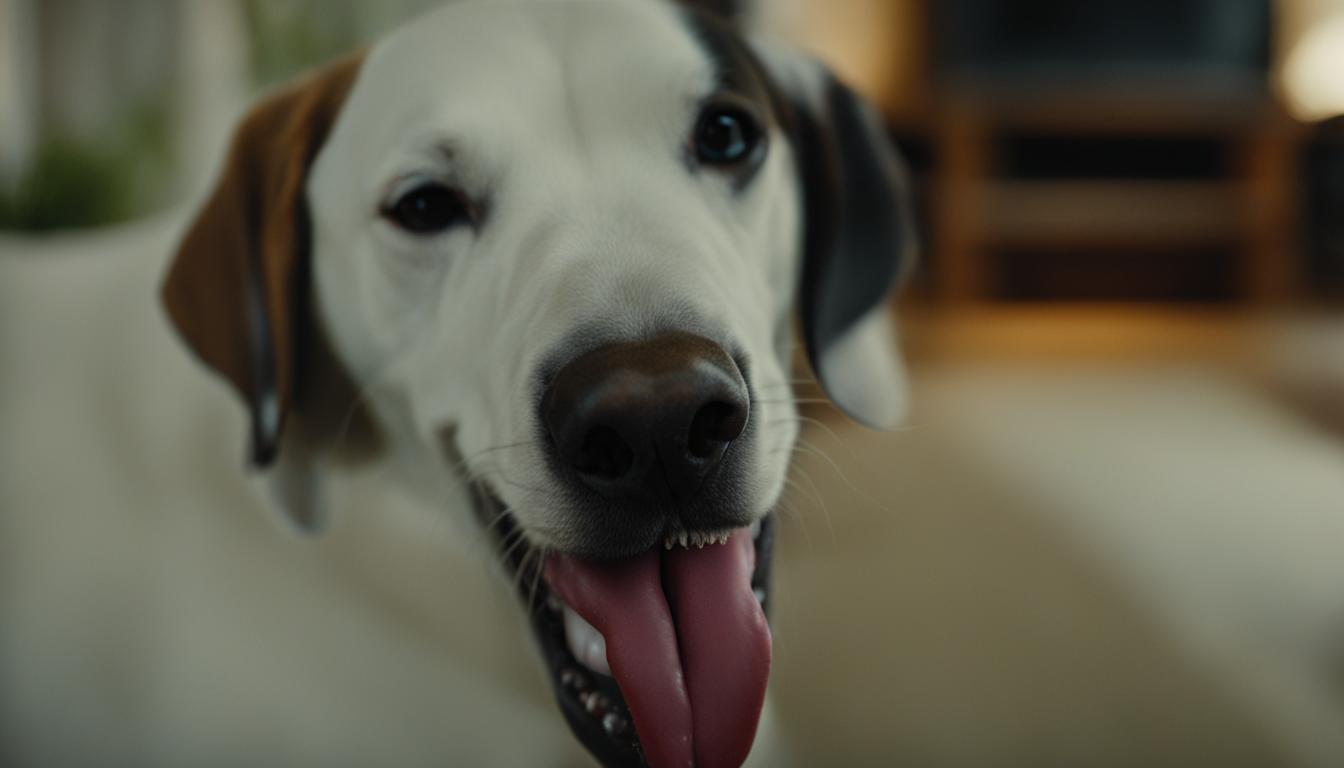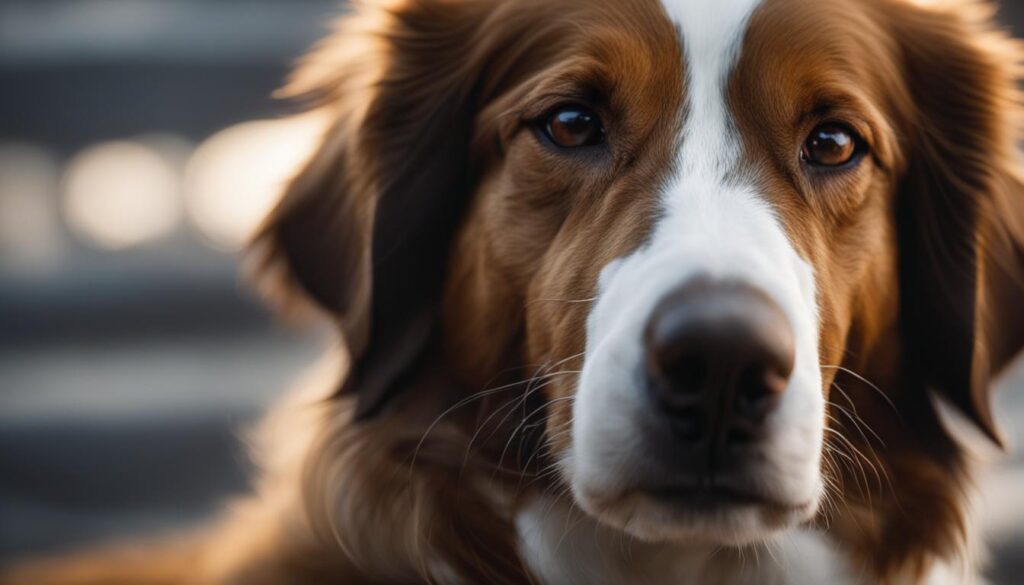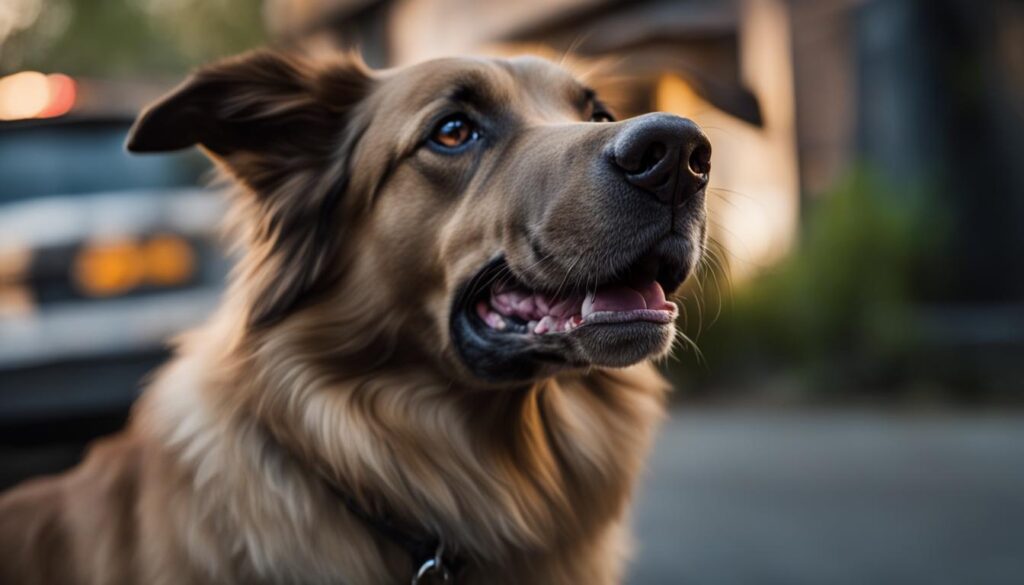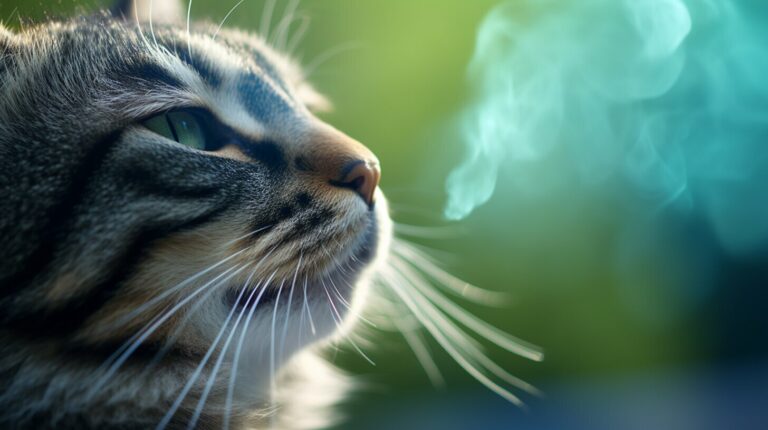Decoding Canine Behavior: Why Do Dogs Lick Their Lips?
I’ve always found dogs fascinating creatures, especially when it comes to their behaviors. One behavior that often piques my curiosity is their tendency to lick their lips. Have you ever wondered why dogs engage in this action? In this article, we’ll delve into the world of canine behavior and uncover the reasons behind why our furry friends lick their lips.
Key Takeaways:
- Dogs lick their lips as a way of communicating with humans and other dogs.
- Lip licking can indicate friendliness, stress, anxiety, or health issues in dogs.
- Understanding canine body language, including lip licking, helps foster a stronger bond with our pets.
- Proper response to lip licking involves positive reinforcement, addressing underlying issues, and seeking professional guidance if needed.
- Decoding canine behavior enhances the canine-human connection and creates a harmonious relationship based on trust and clear communication.
The Meaning of Lip Licking in Dogs
Understanding canine communication is essential for dog owners to establish a strong bond with their furry companions. One intriguing behavior that dogs often exhibit is lip licking. This behavior serves as a non-confrontational way for dogs to communicate their intentions and emotions to other dogs and humans.
Dogs may engage in lip licking as a sign of appeasement and friendliness. It is their way of saying, “I come in peace.” By licking their lips, dogs signal that they do not pose a threat and want to interact in a calm and friendly manner. However, it is important to note that lip licking can also indicate stress or anxiety in dogs.
Recognizing the signs of stress in dogs is crucial for dog owners. Lip licking, along with other body language cues such as lowered body posture, panting, and yawning, can indicate that a dog is feeling uneasy or anxious. By paying attention to these signals, dog owners can better understand their pet’s emotional state and provide them with the support and care they need.
To further decode lip licking in dogs, it is important to consider the context in which it occurs. For example, if a dog licks their lips in a tense or unfamiliar situation, it is likely a sign of stress. On the other hand, if a dog licks their lips after a meal or when anticipating a treat, it is likely a normal behavior related to food. By observing the circumstances surrounding lip licking, dog owners can gain valuable insights into their pet’s behavior and emotions.
The Appearance of Lip Licking in Dogs
Lip licking is a behavior commonly observed in dogs, characterized by a repeated licking motion of the lips. It is a visible and easily recognizable behavior that serves as a form of communication. When dogs lick their mouths, it can indicate various emotions or intentions, and understanding how this behavior appears can help dog owners interpret their pets’ signals.
Lip licking in dogs can occur in different situations and contexts. One common scenario is when a dog perceives a threat or feels anxious. It is a self-soothing behavior that dogs use to calm themselves in stressful situations. Additionally, lip licking can also be a way for dogs to communicate their non-aggressive nature and desire to interact in a friendly manner. Dogs often use lip licking as an appeasement behavior to signal their submission and reduce the likelihood of aggression from perceived threats.
Observing the appearance of lip licking in dogs involves paying attention to the frequency and intensity of the behavior. Some dogs may exhibit occasional and subtle lip licking, while others may engage in more pronounced and repetitive licking. It is important to note that lip licking should be considered in conjunction with other body language cues, such as body posture, tail position, and facial expressions, to gain a comprehensive understanding of the dog’s emotions and intentions.
| Common Situations: | Meaning of Lip Licking |
|---|---|
| Perceived threat or anxiety | Calming behavior, self-soothing |
| Desire to interact in a non-aggressive manner | Appeasement behavior, submission |
In summary, lip licking in dogs is a visible behavior that can provide valuable insights into a dog’s emotional state and intentions. By observing the appearance of lip licking and considering it in conjunction with other body language cues, dog owners can better understand their pets’ communication signals and create a harmonious and supportive environment for them.
The Meaning of Lip Licking in Dogs
Lip licking in dogs is a common behavior that serves as an appeasement gesture and a way to communicate non-aggression. Similar to yawning, lip licking signals submission and a desire to diffuse potential conflicts or threats. When a dog licks its lips, it is essentially saying, “I mean no harm, let’s interact peacefully.”
This appeasement behavior is particularly important in dog-to-dog interactions, as it helps establish a harmonious social hierarchy. By engaging in lip licking, dogs can effectively communicate their intention to maintain a friendly and non-threatening demeanor. It is a way for them to avoid confrontations and promote peaceful interactions within their social group.
Furthermore, lip licking can also be seen as a sign of stress or anxiety in dogs. Just like humans might bite their nails or fidget when feeling nervous, dogs may lick their lips as a self-soothing mechanism. It is important for dog owners to pay attention to the context in which lip licking occurs and consider other accompanying signs of stress or discomfort.
To better understand lip licking in dogs, it is essential to observe the overall body language and context of the behavior. By interpreting the various signals and cues that dogs provide, dog owners can gain valuable insights into their pets’ emotional state and intentions.
Table: Lip Licking Behavior in Dogs
| Behavior | Meaning |
|---|---|
| Lip licking with relaxed body posture | Non-aggressive appeasement |
| Lip licking accompanied by other signs of stress (panting, dilated pupils) | Sign of anxiety or discomfort |
| Rapid and repetitive lip licking | Potential indication of nausea or health issue |
| Lip licking alongside submissive body language (lowered head and tail, ears back) | Submission and non-confrontational behavior |
Understanding the meaning behind lip licking behavior in dogs is crucial for dog owners to enhance their communication and strengthen their bond with their pets. By paying attention to lip licking and the accompanying signals, dog owners can better respond to their dogs’ needs and ensure their overall well-being.
Potential Reasons for Lip Licking in Dogs
Dogs may engage in lip licking for various reasons, and it is important for dog owners to understand the potential underlying causes. By recognizing and addressing these reasons, owners can help their dogs feel more comfortable and secure. Here are some possible explanations for lip licking behavior in dogs:
Stress and Anxiety
Lip licking can be a response to stress and anxiety in dogs. When dogs are feeling overwhelmed or uncomfortable, they may lick their lips as a way to self-soothe. It is important for owners to identify and address the source of stress or anxiety in their dogs’ environments to help reduce lip licking behavior.
Nausea or Dental Issues
Another reason why dogs may lick their lips is due to nausea or dental issues. Dogs may lick their lips to alleviate discomfort in their mouths or to cope with an upset stomach. It is recommended to consult with a veterinarian if lip licking persists or is accompanied by other signs of illness.
Boredom or Environmental Exploration
Lip licking can also occur when dogs are feeling bored or when they are exploring their environments. Dogs may engage in this behavior as a way to occupy themselves or as a form of sensory exploration. Providing mental and physical stimulation, such as interactive toys and regular exercise, can help alleviate boredom and reduce lip licking caused by environmental exploration.
Understanding these potential reasons for lip licking in dogs can assist dog owners in identifying and addressing any underlying issues. It is important to remember that every dog is unique, and consulting with a veterinarian or professional dog behaviorist may be beneficial for individual cases. By addressing the root cause of lip licking behavior, owners can create a healthier and more balanced environment for their furry companions.
| Reasons for Lip Licking in Dogs | Description |
|---|---|
| Stress and Anxiety | Lip licking can be a response to stress and anxiety in dogs. They may engage in this behavior as a way to self-soothe. |
| Nausea or Dental Issues | Dogs may lick their lips to alleviate discomfort in their mouths or cope with an upset stomach. |
| Boredom or Environmental Exploration | Lip licking can occur when dogs are feeling bored or when they are exploring their environments. It may serve as a way to occupy themselves or engage in sensory exploration. |
Interpreting Lip Licking in Dogs
Understanding and interpreting your dog’s body language is essential for effective communication and building a strong bond with your furry companion. One common behavior that dogs exhibit is lip licking, and it can provide valuable insights into their emotions and intentions. By paying attention to the context and associated body language, you can decode what your dog is trying to communicate through lip licking.
Lip licking in dogs can have different meanings depending on the situation. It can be a sign of appeasement, indicating that your dog wants to interact in a non-threatening and friendly way. For example, if your dog is approached by a new person or another dog, they may lick their lips as a way of saying, “I’m not a threat, let’s be friends.”
However, lip licking can also be a sign of stress or anxiety. If your dog is in a situation that makes them uncomfortable or fearful, they may lick their lips as a way to cope with their emotions. It’s important to consider other body language cues such as ear position, eye contact, and overall body posture to get a clearer understanding of your dog’s emotional state.
Signs of lip licking in dogs:
- Tongue flicking over the lips repeatedly
- Moistening the lips with the tongue
- Quickly licking the lips
- Engaging in lip smacking behavior
Remember, every dog is unique, and their body language may vary. It’s important to consider the individual personality and behavior of your dog when interpreting their lip licking behavior.
| Context | Meaning |
|---|---|
| Approached by unfamiliar individuals | Sign of friendliness and non-aggression |
| In a stressful or uncomfortable situation | Sign of anxiety or fear |
| During a veterinary examination | Sign of nervousness or stress |
| After eating or drinking | Common behavior to clean the mouth |
Understanding and interpreting your dog’s lip licking behavior can help you respond appropriately and provide the necessary support. If you notice that your dog is exhibiting excessive or prolonged lip licking, it’s best to consult with a veterinarian to rule out any underlying medical or behavioral issues. By being attentive to your dog’s body language, you can strengthen the bond between you and ensure their overall well-being.
How to Respond to Lip Licking in Dogs
When it comes to a dog’s communication, understanding their body language is essential. One common behavior that dogs exhibit is lip licking. As a dog owner, it’s important to know how to respond appropriately to this behavior to ensure the well-being of your furry friend.
Positive reinforcement is key when addressing lip licking in dogs. When you notice your dog engaging in lip licking, reward them with praise or a treat for displaying calm behavior. This reinforces the idea that lip licking is not associated with stress or anxiety and promotes a positive association.
In addition to positive reinforcement, addressing any underlying anxiety or stress is crucial. If your dog consistently exhibits lip licking in certain situations, consider providing them with a safe and comfortable environment or implementing relaxation techniques such as soothing music or aromatherapy.
If lip licking persists or is accompanied by other signs of distress, it is advisable to consult with a veterinarian. They can evaluate your dog’s overall health and provide guidance on managing anxiety or any underlying medical conditions that may be contributing to the behavior.
| How to Respond to Lip Licking in Dogs |
|---|
| 1. Positive Reinforcement: Reward your dog with praise or treats when they display calm behavior. |
| 2. Addressing Anxiety: Create a safe and comfortable environment, and consider relaxation techniques such as soothing music or aromatherapy. |
| 3. Consult a Veterinarian: If lip licking persists or is accompanied by other signs of distress, seek advice from a veterinarian to rule out any underlying medical conditions. |
The Importance of Understanding Canine Behavior
Understanding canine behavior is crucial for dog owners to build a strong bond with their pets and ensure their well-being. Dogs have their unique ways of communicating, and deciphering their behaviors is key to effective communication. One important aspect of canine behavior is lip licking, which can reveal a lot about a dog’s emotions and intentions.
Canine communication encompasses various forms, including body language, vocalizations, and facial expressions. By paying close attention to these signals, dog owners can gain valuable insights into their pets’ needs and emotions. Lip licking is a behavior that can indicate both positive and negative emotions in dogs.
When a dog engages in lip licking in a relaxed context, such as during grooming or after a meal, it often signifies contentment. However, lip licking can also be a sign of stress, anxiety, or discomfort. It is important for dog owners to interpret lip licking in conjunction with other body language cues, such as ear position, eye contact, and overall posture, to get a comprehensive understanding of their dog’s state of mind.
| Positive Indications | Negative Indications |
|---|---|
|
|
Recognizing and understanding lip licking in dogs allows dog owners to respond appropriately and address any underlying issues. Positive reinforcement for desired behaviors can help alleviate stress and anxiety in dogs, while seeking guidance from a veterinarian may be necessary for addressing potential health concerns. By being attentive to canine body language and actively working to understand their behaviors, dog owners can create a nurturing and fulfilling environment for their furry companions.
Canine Body Language: A Gateway to Understanding
Understanding canine body language is key to developing a deeper connection with our furry companions. By paying attention to their body postures, facial expressions, and vocalizations, we can gain valuable insights into their emotions and intentions. Lip licking is just one aspect of canine body language that can provide important clues about a dog’s state of mind.
When a dog licks its lips, it may indicate a variety of emotions and communication signals. For some dogs, lip licking is a self-calming behavior that helps them cope with stress or anxiety. It can also be a sign of appeasement, a way for dogs to signal their non-aggressive intentions to other dogs or humans. Additionally, lip licking can be a response to nausea or dental discomfort.
To interpret lip licking accurately, it’s crucial to consider the context and other accompanying body language. Is the dog showing signs of tension or relaxation? Are their ears forward or pinned back? Are they making direct eye contact or avoiding it? By observing these cues and integrating them with lip licking behavior, we can better understand what our dogs are trying to communicate.
As responsible dog owners, it’s important to respond appropriately to our dogs’ lip licking behaviors. If we notice signs of stress or anxiety, providing a calm and supportive environment can help alleviate their discomfort. Positive reinforcement for desired behaviors can also reinforce a sense of security and trust. In cases where lip licking is persistent or accompanied by other concerning behaviors, consulting with a veterinarian or professional dog trainer may be beneficial.
Decoding Dogs: Enhancing the Canine-Human Connection
The bond between dogs and humans is a special and unique relationship. As dog owners, it is our responsibility to understand our furry companions on a deeper level, which includes decoding their behaviors and body language. By gaining insights into dog behavior, such as lip licking, we can improve our communication with them and strengthen the dog-human bond.
Understanding dog behavior is key to building trust and creating a harmonious relationship. When we learn to interpret lip licking and other behaviors, we can better respond to our dogs’ needs and emotions. This opens the door to effective communication, creating an environment where our dogs feel understood and supported.
Improving communication with dogs goes beyond simply understanding their behaviors. It also involves active listening and responding appropriately. By paying attention to our dogs’ cues, providing positive reinforcement, and addressing any anxiety or stress they may be experiencing, we can foster a deeper connection based on trust and mutual understanding.
When we take the time to decode our dogs’ behavior and make efforts to improve our communication, we create a stronger bond with our pets. This bond brings joy, companionship, and a sense of fulfillment to both dogs and humans. So let’s embrace the opportunity to enhance the canine-human connection by understanding dog behavior, interpreting lip licking, and building a relationship based on empathy and clear communication.
FAQ
What does lip licking in dogs mean?
Lip licking in dogs is considered an appeasement behavior that indicates a desire to interact in a friendly way or can be a sign of stress or anxiety.
How can I recognize lip licking in dogs?
Lip licking in dogs is easily recognizable as a repeated licking motion of the lips.
Why do dogs engage in lip licking?
Dogs may engage in lip licking for various reasons, including stress, anxiety, perceived threats, nausea, dental issues, or boredom.
How can I interpret lip licking in dogs?
Interpreting lip licking in dogs requires considering the context and associated body language, such as ear position, eye contact, and overall body posture.
How should I respond to lip licking in dogs?
When a dog engages in lip licking, it is important for dog owners to respond appropriately, which can include providing positive reinforcement, addressing anxiety or stress, and seeking guidance from a veterinarian if necessary.
Why is understanding canine behavior important?
Understanding canine behavior is crucial for building a strong bond with dogs and ensuring their well-being.
How does canine body language help in understanding dogs?
Canine body language, including lip licking, serves as a gateway to understanding dogs on a deeper level, allowing dog owners to decipher their needs, emotions, and communication signals.
What is the importance of decoding dog behavior?
Decoding dog behavior, such as lip licking, enhances the connection between dogs and their human companions, enabling a better understanding of their needs, emotions, and communication signals.








